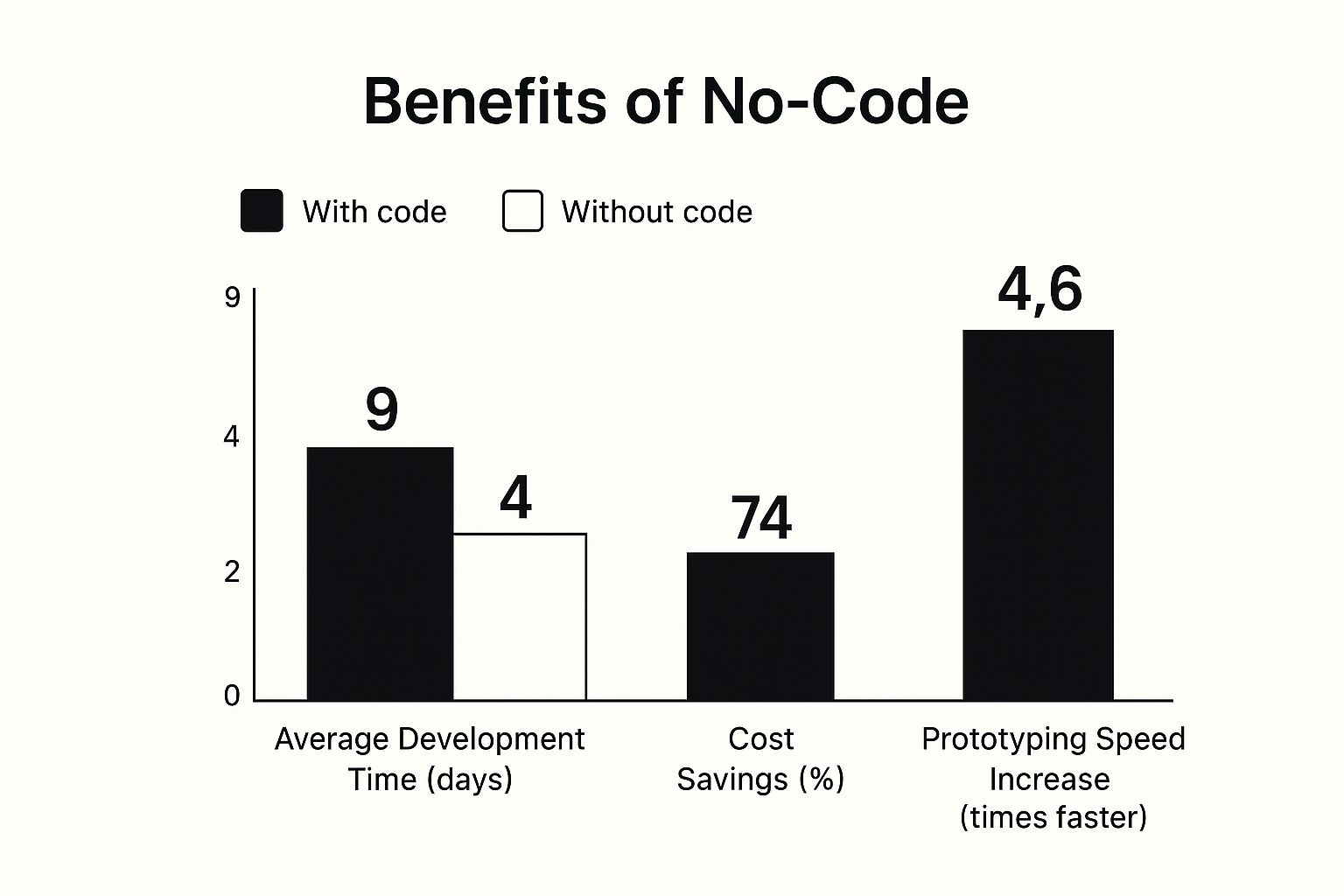Understanding The No-Code Revolution (And Why It Matters)
The app development world is changing. Traditional coding barriers are fading, giving rise to no-code development. This allows individuals with little or no coding experience to create functional, market-ready applications.
This shift isn't a temporary fad. It's a growing movement driven by platforms that empower anyone to build apps without code. These platforms offer intuitive interfaces, drag-and-drop features, and pre-built components, making app development accessible to a broader audience. This democratization empowers entrepreneurs, small businesses, and individuals to innovate and solve problems in new ways.
The Rise of No-Code and Low-Code
The force behind this revolution is the increasing use of no-code and low-code technologies. App development without code has grown significantly. By 2025, 70% of new applications developed by organizations will use these technologies, compared to less than 25% in 2020. This demonstrates the efficiency and accessibility these platforms offer. Find more detailed statistics here. Low-code platforms can reduce app development time by up to 90%, enabling faster development cycles and a more agile approach.
This growth isn't just about speed. It's also about empowering teams to innovate and scale. You might be interested in: How to master SaaS Growth. No-code and low-code platforms facilitate collaboration between technical and non-technical team members on app projects.
The Differences Between No-Code, Low-Code, and Traditional Development
Understanding the differences between these approaches is essential for choosing the right one for your project.
No-code: Requires no coding knowledge. It's like building with LEGOs – assembling pre-built blocks. This is ideal for building simple to moderately complex apps quickly.
Low-code: Bridges no-code and traditional development. It requires some coding knowledge but significantly reduces hand-coding. Think of it as having pre-fabricated building components, but still needing some skills for customization.
Traditional Development: Involves writing code from scratch. This offers maximum flexibility but requires substantial expertise and time. It’s like building a house from the ground up – complete control but a much longer process.
Check out our guide on Introduction for more details.

By understanding the no-code revolution and the differences between these development methods, you can make informed decisions about building your next app.
The Market Explosion Behind No-Code Success
The world of software development is changing. The rise of no-code platforms is undeniable, offering a new way to build applications. Both large corporations and small startups are embracing these platforms, leading to a fundamental shift in how software is created. What's driving this rapid expansion?
Driving Forces Behind No-Code Growth
The increasing developer shortage is a major catalyst. Finding skilled developers is a challenge, and their salaries are rising. No-code offers a solution, allowing businesses to build applications without needing a team of coding experts. This speeds up development and makes it possible for teams with limited technical skills to create functional applications. The democratization of technology is another important factor. No-code empowers non-technical users, often called citizen developers, to contribute to software development. This widespread access to development tools fosters innovation across different departments.
Market Size and Projections
The increasing reliance on no-code is reflected in the market’s impressive growth. The no-code development platform market is expanding rapidly. It’s projected to grow from $28.11 billion in 2024 to $35.86 billion in 2025, representing a 27.6% compound annual growth rate (CAGR). Furthermore, by 2029, the market is expected to reach $93.92 billion, fueled by advancements in areas like AI and machine learning. You can find more details in this report. This growth means the no-code ecosystem is constantly improving, with platforms becoming more powerful and the tools available to non-technical creators becoming more sophisticated.
Opportunities for No-Code Creators
This market explosion is more than just impressive numbers. It shows that businesses recognize the potential of no-code to solve real-world problems. For non-technical individuals, this creates an exciting opportunity to build useful applications and even generate revenue. No-code platforms are becoming increasingly advanced, allowing creators to develop complex and scalable applications without writing any code. This opens doors for entrepreneurs, small business owners, and anyone with an app idea. They can bring their vision to life and potentially disrupt existing markets.
Choosing Your Perfect No-Code Platform
Building an app without code is now much more accessible due to the rise of no-code platforms. However, the sheer number of options can feel overwhelming. This section offers practical advice for navigating the no-code world and choosing the best platform for your project. The right platform is essential for avoiding costly errors and boosting your success. You might be interested in: How to master your startup.
Key Factors in Platform Selection
Several key factors separate the effective no-code platforms from those that underdeliver. Scalability is crucial. Your chosen platform should handle your app's growth without needing a complete rebuild. Integration capabilities are also vital, ensuring it works with your existing tools. Pricing transparency helps avoid surprise costs. Finally, think about the platform's long-term viability. Select a platform with a proven history and a commitment to future development.
Top No-Code Platforms: A Closer Look
Let's explore some popular no-code platforms, highlighting their advantages and disadvantages:
Bubble: Known for its versatility and ability to build complex apps, Bubble offers a robust feature set. However, it has a steeper learning curve.
Webflow: Ideal for visually appealing websites and web applications, Webflow excels at front-end development. However, its backend capabilities are less extensive.
Adalo: Adalo is a good choice for mobile app development, focusing on user-friendliness. However, customization options can be somewhat limited.
To help you compare these platforms, let's take a closer look at their features and pricing in a more structured format. The table below summarizes the key aspects of each platform:
To help you compare these and other platforms, the table below summarizes the key aspects of each platform:
Top No-Code Platforms: Real-World Comparison An honest comparison of leading no-code platforms based on actual user experiences, including pricing, capabilities, and ideal use cases.
| Platform | Best For | Starting Price | Key Strengths | Real Limitations |
|---|---|---|---|---|
| Bubble | Complex web apps | Free | Versatile, powerful logic | Steeper learning curve |
| Webflow | Visually appealing websites | Free | Excellent design tools, easy to use | Limited backend capabilities |
| Adalo | Mobile apps | Free | User-friendly, fast development | Fewer customization options |
As you can see, each platform offers a different balance of ease of use, power, and pricing. Your specific needs will determine which platform is the right fit.
Evaluating Platforms Based on Your Needs
Your project needs should guide your platform choice. Consider your technical skills, budget, and the specific features your app requires. If you're a beginner, choose platforms with intuitive interfaces and helpful tutorials. For complex apps, look for platforms with strong logic and database features. Always test a platform’s free version or trial before purchasing.

This infographic illustrates the advantages of no-code platforms by comparing development time, cost, and prototyping speed against traditional coding. No-code significantly reduces time and cost while dramatically increasing prototyping speed. This shows how no-code can speed up development and get your app to market faster.
Red Flags to Watch For
Before choosing a platform, be wary of certain warning signs. Poor documentation or a small, inactive community can hinder your progress. Platforms with limited integrations or inflexible pricing may restrict you later. Thorough research is crucial for selecting a no-code platform that helps you build, launch, and scale your app successfully.
Your Step-By-Step App Building Journey
Ready to bring your app idea to life? Building an app without code may seem intimidating, but with the right strategy, it's more achievable than you think. This guide walks you through the process, from initial concept to a successful launch, covering essential steps like planning, design, building, and testing. We'll offer practical solutions to common challenges beginners encounter.
Planning Your No-Code App
Before starting to build, careful planning is essential. This initial stage involves understanding user needs, defining features, and creating a roadmap. Begin by gathering user requirements. Consider your target audience and the problems your app solves for them. This informs your feature set and overall app design.
Next, create wireframes, visual representations of your app's layout and functionality. These blueprints guide the development process. They don't have to be perfect, but they should outline the structure and navigation of your app.
Designing the User Interface and Database
With a solid plan, you’re ready to design the user interface (UI) and database. Choosing the right no-code platform is critical at this stage. Explore the options available on platforms like GlideApps.
The UI is the face of your app, and it needs to be both intuitive and visually appealing. No-code platforms offer drag-and-drop interfaces and pre-built components, simplifying the design process. Focus on creating a clean, user-friendly experience. The database, the backbone of your app, stores all necessary information. Think of it as a structured, digital filing cabinet. No-code platforms typically provide user-friendly database builders, letting you define data types and relationships without coding.
Building and Testing Your App
Building with a no-code platform is like assembling with LEGO bricks. Drag and drop components, connect them, and define their behavior. Begin by building your app's core features. This allows for early testing and adjustments. Workflow automation is vital for streamlining in-app processes. It's like setting up automated responses; when a user submits a form, the data is automatically saved to the database.

Thorough testing is essential. Test each feature individually, then in combination with others, ensuring smooth operation. This prevents future errors and ensures a positive user experience. Remember to test on various devices and screen sizes to confirm responsiveness.
Organizing and Structuring Your App
As your app becomes more complex, maintaining an organized structure is key for long-term maintenance and scalability. Divide your app into manageable modules. This lets you focus on specific sections without feeling overwhelmed by the entire project.
Implementing secure user authentication is crucial, particularly if your app handles sensitive data. Most no-code platforms provide built-in authentication features to protect user accounts. Creating intuitive navigation enhances the user experience, ensuring users can easily find what they need. Clear labels and visual cues are essential for guiding users through your app.
By following these steps, you’ll be on your way to creating a functional and user-friendly application without writing any code. This process requires planning, thoughtful design, and a willingness to learn and adapt. Remember, building a successful no-code app is less about coding skills and more about problem-solving and creativity.
The Low-Code Bridge To Greater Flexibility
No-code platforms offer incredible power for building apps without traditional coding. However, sometimes you need more flexibility. This is where low-code solutions come in. They bridge the gap between the simplicity of no-code and the extensive customization offered by traditional coding. Think of no-code as assembling pre-built furniture, while low-code gives you a toolkit to modify pre-fabricated components. This allows for more tailored applications without the complexities of coding from scratch.
Expanding Your App's Potential With Low-Code
Low-code platforms provide greater control over the underlying code, enabling deeper customization and the development of unique features. For example, imagine needing to integrate a specific payment gateway not supported by your no-code platform. Low-code gives you the tools to make this integration possible. Furthermore, low-code empowers both seasoned developers and citizen developers to collaborate, maximizing both speed and customization.
When to Consider Low-Code
No-code excels at rapid prototyping and building functional apps quickly. However, low-code is ideal when your app needs to interact with other systems in complex ways, perform specialized calculations, or when you've outgrown the limitations of a purely no-code approach. Once you've chosen your no-code platform, you can then follow the steps to learn how to build an AI chatbot. This opens up possibilities such as integrating your app with AI tools or building features requiring precise control over data processing.
Real-World Adoption and Growth of Low-Code
Low-code platforms are rapidly growing across various industries. From startups to large enterprises, businesses are adopting low-code to streamline development, reduce costs, and empower their teams. This growth is supported by data. The global low-code development platform market was valued at $28.75 billion in 2024 and is projected to reach $264.4 billion by 2032, growing at a CAGR of 32.2%. Searches for 'low-code' have also increased by 146% over five years. More information on this growth can be found by researching low-code market growth. This highlights the growing interest and investment in low-code solutions as a practical way to build and scale applications.
Integrating Low-Code with No-Code Workflows
Low-code and no-code are not mutually exclusive; they can be powerful allies in app development. Many platforms offer both low-code and no-code capabilities, allowing seamless transitions between the two approaches. This means you can begin with the speed of no-code for your initial build and then transition to low-code as your app evolves and needs more sophisticated features. This hybrid approach offers the speed and simplicity of no-code along with the customization and power of low-code. This adaptability is a key benefit in app development. It allows you to respond to changing market demands and user feedback quickly and efficiently without being held back by technical constraints.
Launching And Scaling Your No-Code Success

Building an app without code is a significant feat, but deploying it effectively is what truly matters. Launching and scaling your app is what separates successful applications from those that fall by the wayside. This section outlines practical strategies to take your no-code app from development to market success, based on the experiences of successful app creators.
Deployment Strategies For No-Code Apps
Deploying your no-code app makes it accessible to users. Many no-code platforms, such as Bubble, offer streamlined deployment options, often with a few clicks. Some platforms allow direct publishing to app stores like Google Play and Apple's App Store, while others generate web links for easy sharing. Understanding your platform's specific deployment methods is essential for a smooth launch. Consider whether your platform focuses on web deployments, specific operating systems, or devices.
App Store Optimization and Marketing
After deployment, App Store Optimization (ASO) becomes paramount. ASO involves optimizing your app's title, description, and keywords to improve its visibility in app stores. Effective ASO can dramatically increase organic downloads. Complement ASO with marketing strategies tailored to no-code apps. This could include content marketing, social media promotion, or targeted ad campaigns. RefGrow offers valuable insights into SaaS growth strategies which could also benefit a no-code app creator. Focus your marketing efforts on the channels where your target audience is most active.
Performance Optimization and User Feedback
Performance is key to any app's success. Regularly monitor your app's performance to identify bottlenecks or areas for improvement. Many no-code platforms offer built-in analytics to track key metrics like user engagement and retention. Equally important is gathering user feedback. Encourage users to provide reviews and suggestions. This feedback helps identify bugs, refine features, and ensure your app meets user needs. This iterative process of improvement is essential for successful no-code development.
Monetization and User Acquisition
Monetization ensures long-term sustainability. Explore different monetization models like in-app purchases, subscriptions, or advertising. Choose the model that aligns best with your app's function and target audience. User acquisition focuses on attracting new users. Cost-effective strategies include social media marketing, content creation, and partnerships. Experiment with different acquisition channels to identify what works best.
Scaling Challenges and Solutions
Scaling a no-code app presents unique challenges. As your user base expands, you might encounter performance issues or platform limitations. Many creators overcome these by migrating to more robust platforms or integrating low-code solutions for added customization and control. Anticipate these scaling challenges and have a plan to address them while preserving the speed and flexibility of no-code development.
The following table provides a roadmap for a successful no-code app launch:
To help visualize the launch process, we've put together a comprehensive roadmap:
The "No-Code App Launch Blueprint" below provides essential milestones, actionable tasks, and realistic timelines for a successful launch.
| Launch Phase | Critical Tasks | Realistic Timeline | Success Indicators | Common Mistakes |
|---|---|---|---|---|
| Planning & Development | Define app purpose, features, and target audience; Design UI/UX; Develop core functionalities | 2-6 months | Clear documentation, functional prototype | Lack of market research, feature creep |
| Testing & Refinement | Internal testing; Beta testing with target users; Gather feedback and iterate on design and functionality | 1-3 months | Positive user feedback, identified and resolved bugs | Insufficient testing, ignoring user feedback |
| Deployment & Launch | Choose deployment platform; Prepare marketing materials; Launch app on chosen platforms | 2-4 weeks | Successful deployment, initial user acquisition | Rushing the launch, inadequate marketing |
| Post-Launch & Growth | Monitor app performance; Collect user feedback; Implement improvements and new features; Scale infrastructure as needed | Ongoing | Growing user base, positive reviews, increasing revenue | Neglecting performance optimization, slow response to user feedback |
This blueprint highlights the key stages and tasks involved in launching a successful no-code app. It also underscores the importance of user feedback and iterative development throughout the entire process. By implementing these launch and scaling strategies, you’ll be well-positioned for long-term success with your no-code application.
Key Takeaways
Building an app without code is now more achievable than ever, thanks to the rise of sophisticated no-code platforms. This section offers practical insights and actionable steps, drawing from real-world examples and proven development strategies. Whether you're a beginner or have experience creating apps, these takeaways provide a roadmap for your no-code app development journey.
Planning and Platform Selection
Before you start building, it's essential to have a clear understanding of your app's purpose and target audience. Defining these aspects will inform your design and development choices, ensuring your app addresses a genuine need. For instance, an inventory management app for small businesses should prioritize simplicity and efficiency for that specific user group.
Choosing the correct no-code platform is critical. Research various options like Bubble, Webflow, and Adalo, considering factors such as scalability, integrations, and pricing. Select a platform that aligns with your technical skills and project requirements.
Just as a house requires a blueprint, your app needs a solid structure. Wireframes are essential for mapping your app's layout, navigation, and user flow. This planning process prevents costly redesigns down the line.
Building Your No-Code App
A clean, intuitive user interface is paramount for a positive user experience (UX). Leverage your chosen platform's design tools to create a user-friendly experience that promotes engagement and encourages users to return.
Begin by developing the core features that define your app’s primary functionality. This allows for early testing and feedback, ensuring you're on the right track.
Testing is non-negotiable. Test individual features, integrated systems, and the entire app on different devices. Thorough testing guarantees a smooth and dependable user experience.
Launching and Scaling
If you’re developing a mobile app, App Store Optimization (ASO) is vital for discoverability. Optimize your app store listing with relevant keywords and a compelling description to improve visibility and drive organic downloads.
After launch, actively seek user feedback. Reviews and suggestions offer invaluable insights for improvements, bug fixes, and future development.
As your user base expands, anticipate scaling needs. Consider integrating low-code solutions or migrating to more robust platforms to accommodate increasing demand and maintain performance.
Essential Checklists For Success
Pre-Development Checklist:
- Defined app purpose and target audience
- Chosen a suitable no-code platform
- Created wireframes and a development roadmap
Building Checklist:
- Designed intuitive UI/UX
- Implemented core features
- Conducted thorough testing
Launch Checklist:
- Optimized app store listing (if applicable)
- Prepared marketing materials
- Established user feedback channels
Avoiding Common Pitfalls
Feature Creep: Resist adding unnecessary features. Focus on core functionalities that provide value to your users.
Ignoring User Feedback: User feedback is invaluable. Don't disregard insights that can improve your app and user satisfaction.
Neglecting Marketing: Even the best app needs promotion. Develop a marketing strategy to effectively reach your target audience.
Building a successful no-code app is an iterative process centered around user needs. By applying these key takeaways and avoiding common mistakes, you'll be well-positioned to bring your app idea to life.
Want to expand your SaaS business with referrals? Refgrow allows you to easily embed a powerful affiliate program directly within your app. Learn more about Refgrow and boost your SaaS growth.

